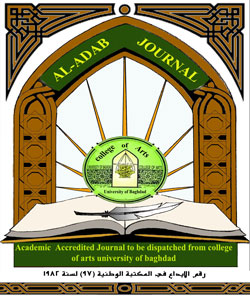Experimentalism In Hilda Doolittle's HERmione
DOI:
https://doi.org/10.31973/aj.v0i112.1539Keywords:
/Abstract
Hilda Doolittle (1886-1946) is an American poet, novelist and translator, generally called H.D. In her Autobiographical novel, HERmione unpublished until 1981, Hilda presents her experimental work in which she imposes a narrative form upon her fictionalized accounts of her tangled personal relations. It is a novel about well-known literary people and a story of forbidden desires, it invokes the patterns of the genre to examine the interpretation of sexuality and textuality in a narrative of development. HER is a literary suppressed, figuratively repressed story of origins whose private telling was essential to public retellings of how Hilda Doolittle became H.D.
Hilda Doolittle's novel is characterized by being revolutionary , experimenting through repetition of names of people , disguised through specific literary language attacking the patriarchal mode of a stern father and a passive , submissive mother. Lights are shed through a psychological approach on the writers traumatic experiences as a result of war consequences on one hand and personal , agonic experiences due to her doubt about her Sexuality being torn between lesbian desire and heterosexual feeling towards a man she loved but was not able to marry.
H.D.'s aim is to create a change in women's state from the conventional treatment of women as an "object" to a new "subject" worthy of description getting benefit from Sigmund Freud's psychological analysis of Hilda Doolittle's character when she was sick. Being an effective imagist and a lover of Arts, she creates a new literary movement depending on common speech and freedom in choosing subjects in a daring style. Since the subject of the novel is about the psychological issues of women's identity problems , feminist critics views like Susan Stanford Friedman , Rachel Blau Duplessis and Helen Cixous's theory of Psychology are taken into consideration in this research
Downloads
References
Augustine, Jane. Myth, Religion, Psychoanalysis Teaching: Hilda
Doolittle and Spirituality
Bertram, Vicki. " kicking Daffodils: twentieth- century Women Poets".
Edinburgh: Edinburgh university Press, 1997.
DuPlessis, Rachel Blau. H.D. The Career of that Struggle. The Harvester
Press, 1986.
Buck, Claire. H.D. and Freud – Bisexuality and a Feminine Discourse.
Hertfordshire:Harvester Wheatsheaf, 1991.
Cixous, Hélène. “Coming to Writing.” Coming to Writing and Other
Essays. Ed. Deborah Jenson. Cambridge: Harvard UP, 1992. 1-
58.
———. “Sorties: Out and Out: Attacks/Ways Out/Forays.” The Newly
Born Woman.91 Hélène Cixous and Catherine Clément. Trans.
Betsy Wing. Minneapolis: U of Minnesota P, 1986. 63-134
Connor, Rachel. H.D. and the Image. Manchester: Manchester
University Press, 2004.
Doolittle, Hilda. HERmione. New York:New Directions Publishing
Corporation, `1981.
-------------------.End to Torment: A memoir of Ezra Pound. New
Directions , 1979.
---------------------.Paint it Today. 1992.
DuPlessis, Rachel Blau. H.D. – The Career of That Struggle. Brighton: The
Harvester Press, 1986.
Encyclopedia of World Biography on Hilda Doolittle. Book Rags, Inc,
2012.
Friedman, Susan Stanford. Penelope's Web: gender, Modernity and
H.D.'s Fiction. New York: Cambridge University Press, 1990.
-----------------------------------.Psyche Reborn: The Emergence of H.D..
Indiana University Press, 1981.
Friedman, Susan Standford and Rachel Blau DuPlessis. “I had two loves
separate”:The Sexualities of H.D.’s Her.” Signets – Reading H.D.
Eds. Friedman and DuPlessis. Madison: U of Wisconsin P, 1990.
205-32.
Galtung, Ingrid. Becoming HERmione : an Exploration of the process of
Subjectivity in H.D.'s Her. Master Thesis. University of Bergen,
2010.
Guest, Barbara. Herself defined: The Poet H.D. and Her world.
Collins,1985.
Featherstone, Simon. War poetry: an introductory reader. Routledge,
1995.
Jenson, Deborah. “Hélène Cixous, Translator of History and Legend: ‘Ce
Transport vertigineux.’” Jouful Babel: Translating Hélène Cixous.
Eds. Myriam Díaz-Diocaretz and Marta Segarra. Amsterdam:
Editions Rodopi: 197-204.
Jones, Peter. Imagist Poetry. Penguin, 1972.
Kristeva, Julia. “The System and the Speaking Subject.” The Kristeva
Reader. Ed. Toril Moi. Oxford: Basil Blackwell, 1986. 24-33.
Morris, Adalaide. How to Live/ what to do :H.D. 's Cultural Poetics.
Chicago: university of IIIinois Press, 2003
Downloads
Published
Issue
Section
License
Copyright and Licensing:
For all articles published in Al-Adab journal, copyright is retained by the authors. Articles are licensed under an open access Creative Commons CC BY 4.0 license, meaning that anyone may download and read the paper for free. In addition, the article may be reused and quoted provided that the original published version is cited. These conditions allow for maximum use and exposure of the work.
Reproducing Published Material from other Publishers: It is absolutely essential that authors obtain permission to reproduce any published material (figures, schemes, tables or any extract of a text) which does not fall into the public domain, or for which they do not hold the copyright. Permission should be requested by the authors from the copyrightholder (usually the Publisher, please refer to the imprint of the individual publications to identify the copyrightholder).
Permission is required for: Your own works published by other Publishers and for which you did not retain copyright.
Substantial extracts from anyones' works or a series of works.
Use of Tables, Graphs, Charts, Schemes and Artworks if they are unaltered or slightly modified.
Photographs for which you do not hold copyright.
Permission is not required for: Reconstruction of your own table with data already published elsewhere. Please notice that in this case you must cite the source of the data in the form of either "Data from..." or "Adapted from...".
Reasonably short quotes are considered fair use and therefore do not require permission.
Graphs, Charts, Schemes and Artworks that are completely redrawn by the authors and significantly changed beyond recognition do not require permission.
Obtaining Permission
In order to avoid unnecessary delays in the publication process, you should start obtaining permissions as early as possible. If in any doubt about the copyright, apply for permission. Al-Adab Journal cannot publish material from other publications without permission.
The copyright holder may give you instructions on the form of acknowledgement to be followed; otherwise follow the style: "Reproduced with permission from [author], [book/journal title]; published by [publisher], [year].' at the end of the caption of the Table, Figure or Scheme.












